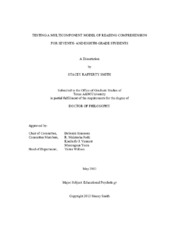| dc.description.abstract | Reading is a complex construct with multiple components that have been theorized and empirically tested. Two multicomponent reading comprehension models were tested in this study to extend understanding of the relation of components skills and to extend prior research by adding a new component of motivation.
A battery of reading measures were completed by 172 seventh- and eighth-grade students that consisted of reading comprehension, vocabulary, background knowledge, inference, motivation, and sentence comprehension fluency. This study examined a full sample of students as well as a subset of students identified as struggling readers for those scoring less than the 25th percentile on comprehension.
Two models were tested for best fit for the Modified DIME and the Multicomponent Model of Reading Comprehension (MMRC). The Modified DIME Model accounted for 63.1% of total variance in reading comprehension. The MMRC also accounted for 63.5% of total variance in reading comprehension after motivation was included as a component of comprehension. Consistent with prior research, findings corroborated the direct influence of multiple components on reading comprehension; most notably vocabulary and the ability to make inferences. Vocabulary provided the largest direct and overall effect in both models. In the Modified DIME Model, vocabulary made the largest direct (.428) and overall contribution (.654) to reading comprehension; vocabulary also held the largest influence for the MMRC both directly (.429) and in overall influence (.653) to reading comprehension. Inference-making was the second-largest direct and overall contributor for both the Modified DIME (.398) and the MMRC (.390). Findings were consistent for both struggling and typical readers in both models. In this study, there was no direct path from motivation to comprehension; however, when direct and indirect relationships were combined, motivation became the third largest contributor to reading comprehension (.186). Motivation was significantly and directly related to comprehension for typical readers (.171, p < .05), but not for those who struggle to read (-.043, p > .05). The findings suggest typical readers with higher motivation perform better on reading comprehension tasks, but there is no direct relationship for struggling readers. Limitations of the study and implications for future research are also discussed. | en |


